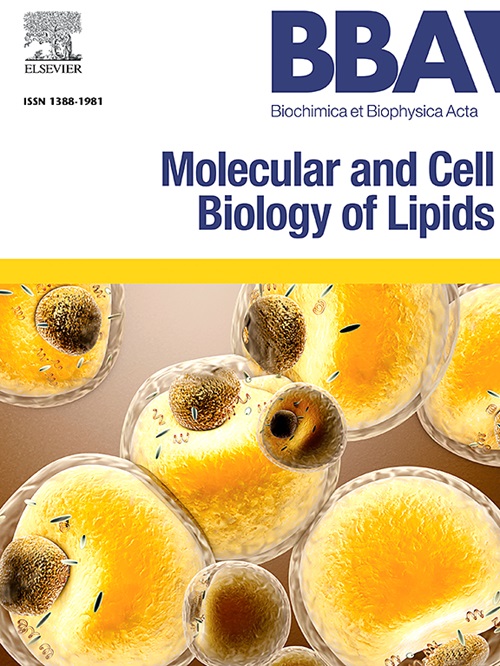在过氧化物酶体缺乏的CHO细胞中,洛伦佐油成分对长链脂肪酸诱导的内质网应激的不同影响。
IF 3.3
2区 生物学
Q2 BIOCHEMISTRY & MOLECULAR BIOLOGY
Biochimica et biophysica acta. Molecular and cell biology of lipids
Pub Date : 2025-07-27
DOI:10.1016/j.bbalip.2025.159670
引用次数: 0
摘要
肾上腺白质营养不良(ALD)是一种由ABCD1基因突变引起的x连锁过氧化物酶体疾病,可导致长链脂肪酸(VLCFAs)的积累。饱和VLCFAs的积累,如C24:0和C26:0,被认为损害髓鞘形成。被称为洛伦佐油的C18:1(油酸)和C22:1(芥酸)的混合物被用来还原这些饱和的VLCFAs。然而,尽管降低饱和VLCFA水平,洛伦佐油被证明对预防神经系统症状无效。在此之前,我们发现在过氧化物酶体缺陷的中国仓鼠(CHO)细胞中补充C18:1可以阻止vlcfa诱导的细胞凋亡。本研究探讨了C18:1的作用机制,并考察了洛伦佐油的另一成分C22:1的作用。补充C18:1完全挽救了vlcfa诱导的细胞凋亡。相反,C22:1增强了VLCFA细胞毒性,降低了C18:1的保护作用。我们发现vlcfa诱导的细胞凋亡是通过内质网(ER)应激反应介导的,可能是内质网结构的破坏,而C18:1可以减弱内质网应激。定量脂质组学显示,VLCFAs主要与磷脂酰胆碱(PC)结合,同时含有C18:1的PC种类显著减少。其中,pc36:2(18:1/18:1)表现出与细胞活力相关的变化模式。这些结果表明,C18:1而不是C22:1通过改善内质网应激反应来保护过氧化物酶体缺陷的CHO细胞,可能是通过改善被VLCFA积累扭曲的内质网结构。本文章由计算机程序翻译,如有差异,请以英文原文为准。

Different effects of Lorenzo's oil components against very long-chain fatty acid-induced endoplasmic reticulum stress in peroxisome-deficient CHO cells
Adrenoleukodystrophy (ALD) is an X-linked peroxisomal disorder caused by mutations in the ABCD1 gene, leading to the accumulation of very long-chain fatty acids (VLCFAs). The accumulation of saturated VLCFAs, such as C24:0 and C26:0, is believed to impair myelination. A mixture of C18:1 (oleic acid) and C22:1 (erucic acid), known as Lorenzo's oil, has been used to reduce these saturated VLCFAs. However, despite lowering saturated VLCFA levels, Lorenzo's oil proved ineffective in preventing neurological symptoms. Previously, we found that VLCFA-induced apoptosis is prevented by C18:1 supplementation in peroxisome-deficient Chinese Hamster Overy (CHO) cells. In this study, we investigated the mechanism underlying the rescue effect of C18:1 and examined the effect of C22:1, another component of Lorenzo's oil. Supplementation with C18:1 completely rescued the cells from VLCFA-induced apoptosis. In contrast, C22:1 enhanced VLCFA cytotoxicity and diminished the protective effect of C18:1. We found that VLCFA-induced apoptosis is mediated via the endoplasmic reticulum (ER) stress response possibly by disruption of ER structure, whereas C18:1 attenuated this ER stress. Quantitative lipidomics revealed that VLCFAs were predominantly incorporated into phosphatidylcholine (PC), accompanied by a significant reduction in PC species containing C18:1. Among these, PC 36:2 (18:1/18:1) showed a pattern of change that correlated with cellular viability. These results indicate that C18:1, but not C22:1, protects peroxisome-deficient CHO cells by ameliorating the ER stress response, likely through improving ER structure distorted by VLCFA accumulation.
求助全文
通过发布文献求助,成功后即可免费获取论文全文。
去求助
来源期刊
CiteScore
11.00
自引率
2.10%
发文量
109
审稿时长
53 days
期刊介绍:
BBA Molecular and Cell Biology of Lipids publishes papers on original research dealing with novel aspects of molecular genetics related to the lipidome, the biosynthesis of lipids, the role of lipids in cells and whole organisms, the regulation of lipid metabolism and function, and lipidomics in all organisms. Manuscripts should significantly advance the understanding of the molecular mechanisms underlying biological processes in which lipids are involved. Papers detailing novel methodology must report significant biochemical, molecular, or functional insight in the area of lipids.

 求助内容:
求助内容: 应助结果提醒方式:
应助结果提醒方式:


